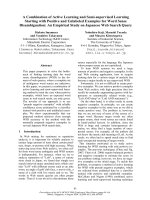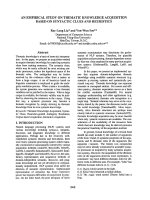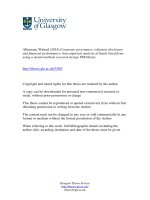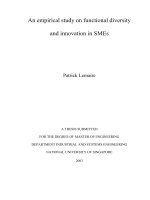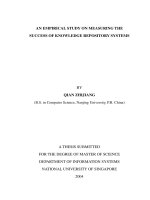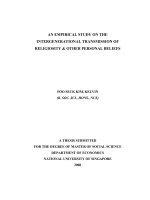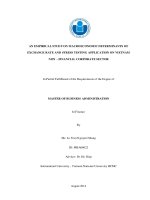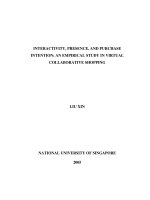Ownership structure, diversification strategy and firm performance an empirical study on chinas listed companies
Bạn đang xem bản rút gọn của tài liệu. Xem và tải ngay bản đầy đủ của tài liệu tại đây (420.96 KB, 215 trang )
Ownership Structure, Diversification
Strategy and Firm Performance
--An empirical study on China’
s listed companies
Wu, Zhijian
NATIONAL UNIVERSITY OF SINGAPORE
2004
Ownership Structure, Diversification
Strategy and Firm Performance
--An empirical study on China’
s listed companies
Wu, Zhijian
(B.E. Fudan University)
A THESIS SUBMITTED
FOR THE DEGREE OF MASTER OF SCIENCE
DEPARTMENT OF BUSINESS POLICY
NATIONAL UNIVERSITY OF SINGAPORE
2004
ACKNOWLEDGEMENTS
I would like to express my greatest appreciation for my supervisor, Andrew Delios,
who has given me cordial encouragement and timely help through the whole two
years of my study in National University of Singapore. It is a great luck and pleasure
to work with Andrew.
I would also like to show my thankfulness to Prof Kulwant Singh and Prof Chung Chi
Nien. Their rigorous and constructive suggestions help to unearth and correct the
potential and flaw of this thesis. Great thanks to the administrative and academic
community of NUS.
Last but not least, I would like to thank my mother and my dad, my uncle and aunt
and all those friends who have helped me in my life.
I
TABLE OF CONTENTS
ACKNOWLEDGEMENTS
I
TABLE OF CONTENTS
II
LIST OF TABLES
VI
LIST OF FIGURES
SUMMARY
VIII
IX
CHAPTER
1. INTRODUCTION
1
1.1
1.2
1.3
1.4
1
5
7
8
Background
Contribution
Findings
Organization
2. LITERATURE REVIEW
2.1
2.2
2.3
2.4
2.5
2.6
Agency Problem
Ownership Structure and Firm Performance
2.2.1 Ownership Structure and Firm Performance in
Developed Countries
2.2.2 The Recent Trend of Privatization and Agency
Problem in Emerging Economies
2.2.3 Addressing the Agency Problem from
the Perspective of Ownership
Antecedents of Diversification: Incentive
2.3.1 External Incentives: Government Policy and Market Failure
2.3.2 Internal Incentives
Outcomes of Diversification: Performance
Ownership Structure and Firm Performance in Asia
Summary
3. OWNERSHIP, DIVERSIFICATION AND FIRM PERFORMANCE
IN EMERGINE ECONOMIES AND CHINA
3.1
Economic Reforms in China
3.1.1 The Transition of China’s Institutional Environment
3.1.2 The Emergence of Stock Markets in China
3.1.3 The Ownership Structure of China’s Listed Companies
9
9
12
13
15
15
18
18
19
20
23
25
28
28
28
37
38
II
3.2
3.3
3.4
3.5
Ownership Structure
41
3.2.1 Ownership Concentration
41
3.2.2 Ownership Identity
42
3.2.3 The difference between state shareholding, legal person shareholding
and individual shareholding
46
Motives of Diversification
48
3.3.1 Diversification in Emerging Economies
49
3.3.2 Diversification in China
50
Product Diversification, Ownership Structure and Firm Performance
51
Summary
53
4. HYPOTHESES DEVELOPMENT
57
4.1
4.2
58
60
60
62
4.3
4.4
Ownership Concentration and Diversification Strategy
Ownership Identity and Dive rsification Strategy
4.2.1 State Ownership
4.2.2 Legal Person Shareholdings
Ownership Structure, Diversification Strategy and Firm Performance
4.3.1 Diversification Strategy and Firm Performance
4.3.2 Ownership Concentration, Diversification Strategy and
Firm Performance
4.3.3 Ownership Identity, Diversification Strategy and
Firm Performance
Rumelt’s Classification
4.4.1 State-controlled Firms
4.4.2 Legal Person-Controlled Firms
64
64
66
69
73
74
75
5. DATA AND METHODOLOGY
78
5.1
78
81
84
84
88
89
92
5.2
5.3
Data
5.1.1 Sample Description
Measures
5.2.1 Dependent Variables
5.2.2 Independent Variables
5.2.3 Control Variables
Methodology
6. RUMELT’S CLASSIFICATION OF DIVERSIFICATION
95
6.1
95
95
96
97
97
6.2
Diversification Measure
6.1.1 Specialization Ratio (SR)
6.1.2 Related Ratio (RR)
6.1.3 Vertical Ratio (VR)
Diversification Category
III
6.3
6.4
6.5
6.6
6.2.1 Linked Relatedness
6.2.2 Dominant Business
6.2.3 Vertical Integration
6.2.4 Conglomerates
6.2.5 Summary of Diversification Categories
Classification of China’s Listed Companies
6.3.1 Specialization Ratio (SR)
6.3.2 Related Ratio (RR)
6.3.3 Vertical Ratio (VR)
Examples of Implementation of Coding Procedure
6.4.1 Example One: Shan Dong Dong-E E-Jiao CO., Ltd
6.4.2 Example Two: Gezhouba CO., Ltd
6.4.3 Example Three: XinJiang TianYe Stock CO., Ltd
China and U.S. Firms: What’s the Difference?
6.5.1 Transition towards diversification of China’s listed companies
6.5.2 Comparison between China and U.S. firms
Summary
98
98
99
99
100
103
103
104
104
105
105
107
108
109
109
113
117
7. RESULTS
120
7.1
7.2
120
121
122
122
123
125
126
127
129
132
132
7.3
Summary of Key Results
Hypotheses Test Results
7.2.1 Hypothesis One
7.2.2 Hypothesis Two
7.2.3 Hypothesis Three
7.2.4 Hypothesis Four
7.2.5 Hypothesis Five
7.2.6 Hypothesis Six
7.2.7 Hypothesis Seven
7.2.8 Control Variables
Summary
8. CONCLUSION
8.1
8.2
8.3
8.4
8.5
135
Ownership Concentration
137
8.1.1 Ownership Concentration and Firm Diversification
137
8.1.2 Ownership Concentration on Firm Diversification and Performance
137
State Ownership
138
8.2.1 State Ownership and Firm Diversification
138
Legal Person
139
8.3.1 Legal Person Shareholding and Firm Diversification
139
8.3.2 Legal Person on Firm Diversification and Firm Performance
139
Rumelt’s Classification
140
Implication and Further Development
143
IV
TABLES
147
FIGURES
179
REFERENCE
185
V
LIST OF TABLES
TABLE 3-1
TABLE 3-2
TABLE 5-1
TABLE 5-2
TABLE 5-3
TABLE 5-4
TABLE 5-5
TABLE 5-6
TABLE 5-7
TABLE 6-1
TABLE 6-2
TABLE 6-3
TABLE 6-4
TABLE 6-5
TABLE 6-6
TABLE 6-7
TABLE 6-8
TABLE 6-9
TABLE 6-10
TABLE 6-11
TABLE 6-12
TABLE 6-13
TABLE 6-14
TABLE 6-15
TABLE 6-16
TABLE 6-17
TABLE 7-1
TABLE 7-2
TABLE 7-3
TABLE 7-4
Share Classification (Percentage) for the Chinese Stock Market from
1993 to 2002
148
Comparison between the literature on developed countries and
emerging economies
149
Data Source
150
Distribution of the Sample Firms across Industry Categories (2001)
151
Equity Structure of Listed Companies
152
Ownership Concentration for China’s listed companies in 2002
153
Variable Description Summary
154
Correlation Matrix (1)
155
Correlation Matrix (2)
156
Revenue Breakdowns of Different Business Sectors of North
American Rockwell in 1969
157
Vertically Rela ted SIC Codes
157
Two, Three and Four Digit SIC Codes and Revenue Breakdowns of
Business Sectors of Shan Dong Dong-E E-Jiao Co., Ltd (2001)
158
Revenue Percentages by 2-digit SIC Code for Shan Dong Dong-E EJiao Co., Ltd (2001)
158
Summary of Diversification Measures and Categories
158
Two, Three and Four digit SIC Codes and Revenue Breakdowns of
Business Sectors of Gezhouba CO., Ltd (1999)
159
Revenue Percentages By 2-digit SIC Code for Gezhouba CO., Ltd
(1999)
159
Two, Three and Four digit SIC Codes and Revenue Breakdowns of
Business Sectors of XinJiang TianYe CO., Ltd (1999)
160
Revenue Percentages By 2-digit SIC code for XinJiang TianYe CO.,
Ltd (1999)
160
Summary (number) of the category of China’s listed companies by
year
161
Summary (percentage) of the category of China’s listed companies by
year
162
Observed Percentage of Firms in Each Strategic Category
163
Firms listed from 1995 through 1998 to 2002
163
Comparison of a Five-year period for Firms initially listed from 1995
to 1997
164
Transition Rates for 1995-1998 Projected Through 2002
165
Rumelt’s Estimated Percentage of Firms in Each Strategic Category
165
Rumelt’s Transition Rates for 1949-1959 Projected Through 1969 165
Summary of Empirical Results
166
Ownership Concentration and Firm Diversification
167
Firm Diversification and State Ownership
168
Firm Diversification and Legal Person Shareholding
169
VI
TABLE 7-5
TABLE 7-6
TABLE 7-7
TABLE 7-8
TABLE 7-9
TABLE 7-10
TABLE 7-11
TABLE 7-12
TABLE 7-13
Firm Performance and Firm Diversification (1)
170
Firm Performance and Firm Diversification (2)
171
Firm Performance, Firm Diversification and Ownership Concentration
(1)
172
Firm Performance, Firm Diversification and Ownership Concentration
(2)
173
Firm Performance, Firm Diversification and State Ownership (1) 174
Firm Performance, Firm Diversification and State Ownership (2) 175
Firm Performance, Firm Diversification and Legal Person (1)
176
Firm Performance, Firm Diversification and Legal Person (2)
177
Performance Comparison for Firms (1991-2002)
178
VII
LIST OF FIGURES
FIGURE 6-1 Product Flow and Revenue Breakdown for Alcoa in 1969
180
FIGURE 6-2 Assigning Diversification Categories
181
FIGURE 6-3 Observed Percentage of Firms in Each Strategic Category (Major
Classes)
182
FIGURE 6-4 Observed Percentage of Firms in Each Strategic Category (Minor
Classes)
182
FIGURE 7-1 Firm Diversification and Legal Person Shareholding (Random Effect)
183
FIGURE 7-2 Firm Performance, Firm Diversification and Legal Person Ownership
(Fixed Effect: 1991-2002)
184
VIII
SUMMARY
Corporate governance has been a subject of intensive research efforts by scholars but
with a distinct and overwhelming focus on U.S. and European firms. Using agency
theory as a theoretical basis, researchers have studied the implication of ownership
structure and diversification strategy on a firm’s performance in developed economies.
Such studies in emerging market economies are comparatively limited. I integrate
existing research on ownership structure, diversification strategy and firm
performance in a study that looks at these issues for firms listed on China’s Shanghai
and Shenzhen stock markets. The setting of China provides good opportunities to test
the robustness of previous findings in a unique and changing institutional setting. I
explore these issues using traditional measures of ownership, diversification and
performance along with Rumelt’s classification of diversification strategy.
The data to be tested consist of all the China’s listed companies from 1991 to 2002, as
compiled from multiple archival sources. I discuss both the outcomes and evolution
patterns of these firms’diversification strategies in this thesis.
My study has four major streams of findings. First, I find that ownership
concentration is negatively related to firm diversification. In addition, I find that state
shareholding is also negatively related to firm diversification. Secondly, I find a
positive relationship between China’s firms’diversification and performance, which
is against the conventional wisdom derived from observations of firms in the Western
IX
countries (Servaes, 1996). The third set of my findings is about the contingent effect
of ownership structure on the relationship between firm diversification and firm
performance. I find that legal person moderates the relationship between firm
diversification and firm performance (Figure 7-2). Here the moderating effect means
that Legal Person Shareholding makes the slope of the inverted U-shape curve
between firm diversification and firm performance more flat. Finally, I did not find a
significant performance gap between firms of various diversification categories based
on Rumelt’s scheme, but I find Conglomerates and Single Business firms to show
much better performance than Dominant Unrelated firms. In addition, I find a general
trend towards higher levels of firm diversification for all the China’s listed companies
through the decade after the two stock markets were established.
Key words: corporate governance, ownership structure, diversification strategy
X
CHAPTER 1
INTRODUCTION
CHAPTER 1
INTRODUCTION
1.1 Background
Corporate governance has been the focus of decades of research (Ravenscraft &
Scherer, 1987; Hoskisson & Turk, 1990; Morck et al., 1988; Shelifer & Vishny,
1997). This research stream emerged with the modern form of corporation in which
there was a separation of finance (ownership) and management of firms. This
separation may be due to the fact that as the scale of firms kept growing, the owner of
the firm began to lack expertise or time to monitor its daily operations. Therefore,
professional managers were introduced into the management and supervised the
operation of the firm on the behalf of the owner (Coase, 1937). Agency theory has
thus developed to deal with the agency problems that arise when an owner allocates
management rights to professional managers.
Although the research of corporate governance and agency problem has been
conducted in America and Europe for decades, scholars have given little attention to
this issue in emerging economies until recently. The global privatization trend has
directly and indirectly led to the emergence of increasing numbers of private
corporations in many transitional economies. Additionally, many governments of
1
CHAPTER 1
INTRODUCTION
emerging markets launched reforms of state-owned enterprises (SOEs) and led these
firms toward the form of so-called modern companies, which are very close to the
organizational and management structure of firms in the West. Researchers looking at
issues pertinent to these firms have grounded their work in the extensive studies on
the topic of corporate governance completed in the context of developed economies
(Jensen and Meckling, 1976; Fama, 1980; Bulow & Rogoff, 1989). Despite this
grounding, analogous research on transitional economies still remains relatively
limited (Xu and Wang, 1997).
Currently, increasing numbers of scholars are beginning to focus research efforts on
China, as it is one of the largest and fastest growing markets in the world. Aside from
the rapid growth of China and its continued integration into the world economy, its
unique
emerging
institutional
infrastructure
provides
substantial
research
opportunities to deepen our understanding of core issues in firm- level and corporate
strategy (Xin and Pearce, 1996; Luo and Tan, 1997; Lins, 2002; Sun et al., 2002).
I situate my study in the corporate governance and ownership structure literature
(Berle and Means, 1932; Demsetz and Lehn, 1985), as China’s transition to a market
economy has resulted in several ownership identities attaining a prominence not
typically seen in Western European and North American firms. This emergence of
unique ownership identities allows us to bridge research on the ownership
concentration effect to the ownership identity effect. In developed economies,
researchers have offered conflicting arguments on the relationship between ownership
2
CHAPTER 1
INTRODUCTION
concentration and a firm’s performance, including positive, negative and insignificant
effects (Denis and Denis, 1994; McConnell and Servaes, 1990; Leech and Leahy,
1991; La Porta, et al., 1999). Scholars have also uncovered that different types
(identities) of shareholders exert significantly different effects on corporate
performance. A general finding, for example, is that state shareholdings tend to be
inferior to private shareholdings and institutional shareholdings for promoting
corporate performance, with limited exceptions (Shapiro and Willing, 1990; Prowse,
1994; Hufft, 1998).
In addition, I incorporate research on the ownership structure with that on a firm’s
diversification strategy. Firm diversification is important because managers have
considerable discretion and may not always follow optimal decision processes as
based on the maximization of shareholders’ interests (Child, 1972; Hitt & Tyler,
1989). There are various factors that will lead management to diversify, which also
have distinct implications for firm performance. Scholars have contended that
ownership structure, market forces, government intervention, management of external
relations and skill building can each possibly become a motive for a firm to diversify
(Tan & Li, 1996; Li & Tse, 1997; Li et al., 1998). The relationship between
ownership structure and diversification strategy also has important implications for a
firm’s performance (Baysinger & Hoskisson, 1990; Hoskisson & Turk, 1990).
Scholars argue that firms pursuing a related diversification strategy tend to
outperform those following an unrelated diversification strategy (Zhao & Luo, 2002).
3
CHAPTER 1
INTRODUCTION
Given the above, I have derived several reasons as to why there are benefits to
studying the mutual relationship between ownership structure, firm diversification
and firm performance in China.
(1) The listed companies in China are tremendously diversified. Based on
Rumelt’s diversification scheme (Rumelt, 1974), I find that more than forty
percent of Chinese listed companies fall into the category of Unrelated/Conglomerate (Table 6-11). This figure is rather eye-opening when I
compare it to the historical levels of diversification in the United States and
other developed countries (Rumelt, 1974). Consequently, I want to know
under what circumstance companies have evolved into a diversified situation,
what are the motivations for these companies to diversify, and what are the
performance implications of their diversification strategies.
(2) In China, there is a pervasive existence of state shareholding (Table 3-1). This
is very different from the essential non-existence of state shareholding in
developed countries such as the United States. I would like to study the
different role s that state shareholding has played in influencing firms’strategy
and performance.
(3) The transition of Chinese firms’ownership has been rapid, as facilitated by the
creation of legal person ownership. The emergence and existence of legal
person shareholding is consistent with the transition stage of China’s
economic situation and institutional environment. Legal person ownership
functions as a bridge between state shareholding and private shareholding to
4
CHAPTER 1
INTRODUCTION
help smooth the economic transition of China. I want to study the role of such
a temporary type of shareholding.
(4) The diversification evolvement for Chinese listed companies is much more
rapid than those companies in the United States. For Chinese listed companies,
they either do not choose to diversify, or choose to diversify rapidly to a high
level (see Chapter 6 for details). I would like to study whether the context
matters— compared to developed countries, China is under a transition stage
and its firms seem to be behaving differently from those in U.S. or Japan.
1.2 Contribution
In this thesis, I will identify several areas in which new research could be comp leted,
to address issues and questions that remain unresolved in the existing literature.
(1) Scholars have done quite an amount of research on diversification in emerging
economies. However, there is still potential for research to improve our
understanding of this phenomenon in developed countries and developing
countries. The emerging phenomenon of diversification in developing
countries heightens the need to identify the reasons for the emergence of this
phenomenon (Why do the firms choose to diversify?) and its consequence
(How does this strategy affect a firm’s performance?) It would be even more
interesting to study the discrepancies of the effects of diversification between
developed countries and developing countries, perhaps using an institutional
economics approach.
5
CHAPTER 1
INTRODUCTION
(2) Studies on a firm’s ownership structure in emerging economies have produced
ambivalent sets of results. However, few studies have linked these firms’
diversification strategy with the transition of a firms’ownership structure. By
linking the diversification strategy to ownership structure, I would hope to
understand better the motivations, consequences and implications of firm
diversification on firm performance from a new strategic perspective, which
would link the macro effect (China’s institutional transition environment) and
micro effect (firm ownership transition and diversification strategy) together.
(3) In this thesis, I develop an analysis of China’s listed firms’diversification
strategies that is consistent with Rumelt’
s diversification classification. I find
that China’s listed companies are undergoing a process of evolution during the
period of 1991 to 2002, the details of which will be discussed in Chapter six.
Additionally, I try to identify the factors that influence a firm’s strategy of
diversification, such as institutional change, ownership structure, and so forth.
(4) Using Rumelt’s classification which was built based on U.S. firms; I have
found a different diversification trend of China’s firms. Compared to
developed countries, China is under a transition stage and its firms are
behaving differently from those in U.S. or Japan. This result should stimulate
research on the implications of these trends for firm performance and other
possible future evolution.
6
CHAPTER 1
INTRODUCTION
In my thesis, I try to answer the above questions. I will establish an empirical model
to test the data on China’s listed companies, and try to make contributions in both
theoretical and empirical respects.
1.3 Findings
My study has four major streams of findings. The first stream is about the relationship
between ownership structure and firm diversification. I find that ownership
concentration is negatively related to firm diversification. In addition, I find that state
shareholding is also negatively related to firm diversification. Secondly, I find a
positive relationship between China’s firms’diversification and performance, which
is against the conventional wisdom in the Western countries (Servaes, 1996). The
third set of my findings is about the contingent effect of ownership structure on the
relationship between firm diversification and firm performance. I find that legal
person moderates the relationship between firm diversification and firm performance
(Figure 7-2). Here the moderating effect means that Legal Person Shareholding
makes the slope of the inverted U-shape curve between firm diversification and firm
performance more flat. Finally, I did not find significant performance gaps between
firms of various diversification categories based on Rumelt’s scheme, but I find that
Conglomerates and Single Business firms show much better performance than
Dominant Unrelated firms. In addition, I find a general trend towards higher levels of
firm diversification for all the China’s listed companies through the decade after the
two stock markets were established.
7
CHAPTER 1
INTRODUCTION
1.4 Organization
There are eight chapters in this thesis. The chapters are organized as follows.
Chapter 2 provides a review of research on the relationships between ownership
structure, diversification strategy and firm performance. Chapter 3 reviews the
literature on the relationship between ownership structure, diversification strategy and
firm performance in both emerging economies and China. In Chapter 4, I establish
several hypotheses, which predict the relationships between ownership structure, a
firm’s diversification strategy and firm performance in the China context. Chapter 5
describes the data and the methodology I use to test the hypotheses. In Chapter 6, I
introduce the definitions, concepts and methodology of Rumelt’s diversification
scheme, with a specific description of how I used his classification scheme in the
context of China. Chapter 7 provides the results of the empirical tests, which is based
on the data described in the previous chapter. In chapter 8, I discuss the results and
implications, and conclude the thesis with a discussion of its contributions and the
introduction of some ideas about the potential for future research.
8
CHAPTER 2
LITERATURE REVIEW
CHAPTER 2
LITERATURE REVIEW
This chapter provides a review of research on the mutual cross-relationships among
ownership structure, diversification strategy and firm performance. There are five
sections in this chapter. The first section reviews agency theory as the theoretical
basis of my thesis. The second section covers studies concerned with the relationship
between ownership structure and firm performance. Section three and section four
introduce research on the antecedents and consequences of a firm’s diversification
strategy. Each of the first fo ur sections is composed of theoretical studies and
empirical studies. Finally in section five I summarize my argument.
2.1 Agency Problem
In the study of the relationships between ownership structure, firm diversification
strategy and firm performance, agency theory has been the foundation for most
studies. I first review work related to the agency problem.
The agency theory was fully developed by Coase (1937), Jensen and Meckling (1976),
and Fama and Jensen (1983). Agency theory was developed on the assumption of
economically rational human behavior and co-emerged with the separation of
management and finance. In modern public corporations, shareholders have the right
9
CHAPTER 2
LITERATURE REVIEW
to control and the right for dividend in return for the ownership. The owners of a firm,
however, may lack the essential knowledge or expertise to manage the operations of a
firm efficiently. Therefore, owners introduce professional managers to carry on the
daily operations of the corporation. The owners need the managers’ expert and
professional skills to effectively manage the firm and make profits. The managers
need the owner’s funds to put his ability to good use. The agency problem comes out
when the owners have difficulty assuring that their funds are not expropriated by the
managers, such as being not used for the purpose of profit maximization (Shleifer &
Vishny, 1997).
Managers with significant control rights over the allocation of investors’funds may
expropriate them. In general, managers can expropriate the investor’s funds in two
ways: perquisite consumption and entrenchment. Perquisite consumption refers to the
manager’s cost-enhancing activities to increase his non-salary income and other onthe-job consumption (Gedajlovic & Shapiro, 1998). Entrenchment refers to the
manager’s activities to entrench himself and ensure his management position in the
cost of firm’s profitability (Walsh & Seward, 1990). The pyramid scheme is another
good example of expropriation. A pyramid scheme is established by continuously
joining people, who paid credits to those who joined earlier into the hierarchy and
expect to obtain payments from those who joined afterward. In many pyramid
schemes, the top management ends up absconding with the money. Managerial
expropriation of funds can also take other forms than just taking the cash out. For
example, managers may book the most luxurious hotel and enjoy the most expensive
10
CHAPTER 2
LITERATURE REVIEW
flight during a business trip. Sometimes the above situations may result in poor
consequences for shareholders. The owners of a firm must have a strategy to deal
with these potential agency problems.
Existing work suggests that agency problems can be resolved through several
approaches. First, scholars have suggested that owners grant the manager a highly
contingent, long term incentive contract ex ante to align his interests with those of
investors. Just as Shleifer and Vishny argued, “in this way, incentive contracts can
induce the manager to act in investors’ interest without encouraging blackmail,
although such contracts may be expensive if the personal benefits of control are high
and there is a lower bound on the manager’s compensation” (Shleifer & Vishny,
1997). Incentive contracts can take a variety of forms, including share ownership,
stock options, or a threat of dismissal if the firm’s performance is under the
expectation (Jensen & Meckling, 1976; Fama, 1980).
Second, the agency problem can be addressed by methods other than supervision. For
example, people sometimes carry on the promise even if they are not forced to do so
because they want to keep their reputation (Kreps, 1990). In a business world where
information is highly circulated, a manager will have to behave himself for the future
preparation if he wants to raise capital or abandon his occupation in favor of another.
On the other side of the coin, it is also argued that reputation restriction may cause a
backward recursion problem (Bulow & Rogoff, 1989). For example, when the future
possible benefits for the manager is lower than what the manager is able to
11
CHAPTER 2
LITERATURE REVIEW
expropria te from the current investor, rationally the manager may choose to cheat the
firm owner.
Third, agency problems can be solved through an effective principal monitoring of
agents (Beatty & Zajac, 1994; Mallette & Fowler, 1992; Zahra & Pearce, 1989; Zajac
& Westphal, 1994). Shareholders can resort to legal protection for the purpose of
supervision. One of the most important legal rights shareholders have is the right to
vote. Shareholders have the legally protected right to vote for important strategic
decisions of a firm such as merger and acquisition and the election of board directors
(Manne, 1965). It should be noted that the effectiveness of voting rights depends on
the legal environment. In countries where the legal enforcement is weak and the
protection of minority shareholder is frail, managers may not be constrained or
threatened that much. For example, in China it is requested that shareholder should be
present on shareholder meeting to exercise the voting rights. Some managers or
director candidates threatened the shareholders and compelled them not to go to the
meeting (Shleifer & Vishny, 1986).
Scholars have also recognized that effective governance mechanisms, such as boards
of directors (BODs), managerial labor markets, and takeover threats, can also be
effective in resolving agency problems (Bhide, 1994; Franks & Mayer, 1993; Prowse,
1994; Walsh & Seward, 1990).
2.2 Ownership Structure and Firm Performance
12
CHAPTER 2
LITERATURE REVIEW
2.2.1 Ownership Structure and Firm Performance in Developed Countries
Numerous studies have been done to explore the relationship between a firm’s
ownership structure and its performance. Generally, scholars have studied the effect
of ownership structure from two perspectives: ownership concentration and
ownership identity.
Many scholars fo llow Berle and Means’(1932) hypotheses about widely dispersed
ownership to further the research in the field of ownership concentration. For
example, Shelifer and Vishny (1997) argued that ownership concentration has a twofaced effect on corporate performance. On one hand, in a firm that has many owners
of small shares of its equity and no owner of large shares, most owners cannot be
involved in the ongoing management of the firm. Additionally, minority shareholders
may be discouraged to keep monitoring the firm’s management by a free-rider
problem: the free-rider can enjoy the benefits as long as other shareholders exercise
the monitoring responsibility.
On the other hand, there are several potential costs of having controlling shareholders
in a firm such as inefficient expropriation of a firm’s assets by block-holders and the
possible expropriation on minority shareholders. Not surprisingly, empirical studies
about the relationship between ownership concentration and firm performance have
yielded conflicting results. While Berle and Means (1932) found an inverse
relationship between ownership concentration and corporate performance, Demsetz
13


